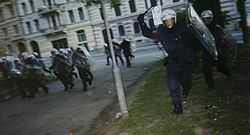Baton charge

A baton charge is a coordinated tactic for dispersing crowds of people, usually used by police or military during public order situations. In certain countries, police are not authorised to use the tactic unless no other means can be practiced.
The tactic involves police officers charging at a crowd of people with batons and in some cases, riot shields. They run at the crowd hitting people with their batons, and in some situations use riotshields to push them away. Baton charging is designed to cause the maximum amount of pain, in the hope that they would be compelled to move away from the scene, dispersing the crowd.
India
In India, a baton would often be referred to as a lathi. Some Indian police forces use lathis around 5 ft long, but in other places lathis are shorter. The term lathi charge is used by the Indian media more commonly than "baton charge".[1] The lathi drill is taught to all Indian police recruits. The tactic is controversial among human rights campaigners due to the violence involved.
See also
References
- ↑ Police lathi charge protesters Times of India-Retrieved 29 July 2010